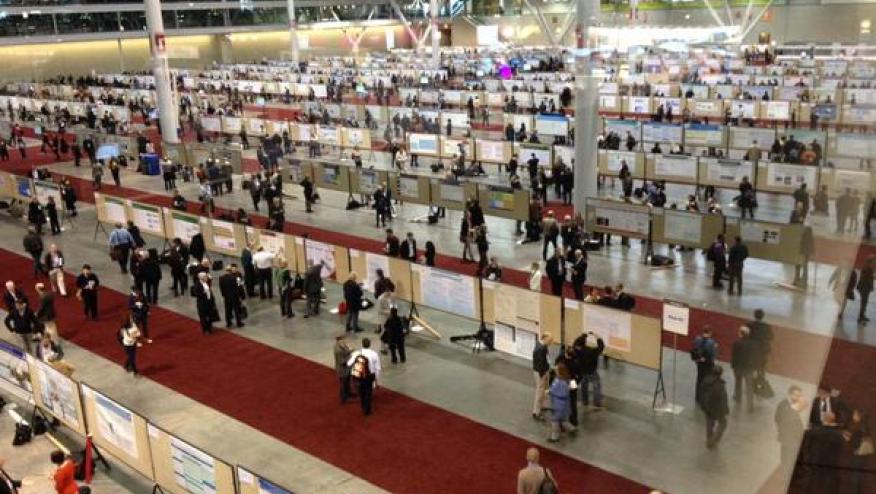EULAR 2017 – Day 3 Highlights Save

Friday was a mega-day in Madrid as this day all the late-breaking (LB) abstracts were presented, in addition to the bulk of high-impact podium presentations in several areas.
Here are the major presentations from several clinical areas:
Lupus
- One-Two Punch for Lupus Nephritis: This abstract for me was the Standout of EULAR17! This as a novel, proof-of-concept trial that sought to treat severe lupus patients first with 2 standard doses of rituximab (RTX), followed by a loading regiment of belimumab (BEL; weeks 0, 2, 4) and then BEL every 4 weeks. This was presumably proposed given the mixed or disappointing results with RTX or BEL in SLE or because of the well-known elevations of BAFF with SLE, and that elevated BAFF levels after RTX may contribute to the inconsistent findings with RTX in SLE. They treated 14 patients, 79% of whom had lupus nephritis, all with active serologies and the mean SLEDAI=18. All patients were on mycophenolate (MMF) at the start and high doses of prednisone. The protocol mandated weaning of prednisone and suggested MMF weaning. The responses were dramatic such that nearly all patients improved by weeks 12 and 24, proteinuria resolved, low complements and high dsDNA corrected, all were on 5-7.5 mg of prednisone and off MMF at week 24. Even better were the basic studies done with this trial that showed that high levels of netosis present at the start dramatically reduced with combo therapy and that netosis could be correlated with clinical activity by SLEDAI. Look for this presentation at ACR 2017 in San Diego!
- Voclosporin in lupus Nephritis: The AURA-LV study (LB0002), 24 week results were presented at ACR 2016 and EULAR presented the week 48 voclosporin ( a calcineurin inhibitor) findings. 245 patients with lupus nephritis all were on mycophenolate and steroids and received either placebo, low or high doses voclosporin and they found complete renal responses in 33% at week 24 and 49% at week 48. While encouraging there were high rates of serious adverse events (AE: ~25%) and a total of 13 deaths among these severe lupus patients.
Spondyloarthritis
- Ustekinumab for Enthesitis: Araujo et al (OP0217) reported on a small open, prospective study of ustekinumab (UST) vs. TNF inhibitor (TNFi) in 47 patients with psoriatic arthritis (PsA) and enthesitis. Patients had moderate joint involvement with TJC and SJC ~5 along with their active enthesitis. At 6 months the results significant favored UST (75% improvement vs ~40% with TNFi) in enthesitis scores and psoriasis skin improvement (>60% vs ~25% PASI75); but no differences in the level of joint improvement by ACR20 (>40% for both).
- Fast Apremilast in Biologic Naïve PsA: a new Phase III trial examined APR in PSA – the “Active Study” was presented by Dr. Peter Nash. Apremilast was compared with placebo (PBO) and significantly greater APR responses were seen at weeks 16 and 24 (44% vs 25% PBO).Interestingly, they found a significant fast response difference at 2 weeks (16.4% vs 6.4%. Serious adverse events were rare and nearly 9% had to withdraw for an AE.
Rheumatoid Arthritis
- Less Surgery in the Biologic Era: Cordtz et al presented the results of a population based observational study in Denmark that examine rates of either total hip (THR) or knee replacement (TKR) in 1022 RA patients followed prospectively from 1996 to 2016. They identified 2002 as the year biologics were introduced and new guidelines for rational pharmacotherapy were introduced. Rates for THR and TKR prior to 2002 were established for RA patients and compared 10:1 with the general population controls (GPC). They found that post-2002, rates of both TKR and THR sharply declined, whereas the GPC TKR rates continued at nearly the same rate. These findings are similar to that recently reported in the UK. Clear evidence that aggressive therapy with biologics can substantially reduce the need for surgery. In the pre-biologic era most of the cost of RA care was from hospitalization and the need for orthopedic surgery. In the biologic era, the cost has not changed, but we have shifted the costs from surgery to the cost of biologic utilization.
ADD THE FIRST COMMENT
Disclosures
The author has received compensation as an advisor or consultant on this subject









If you are a health practitioner, you may Login/Register to comment.
Due to the nature of these comment forums, only health practitioners are allowed to comment at this time.